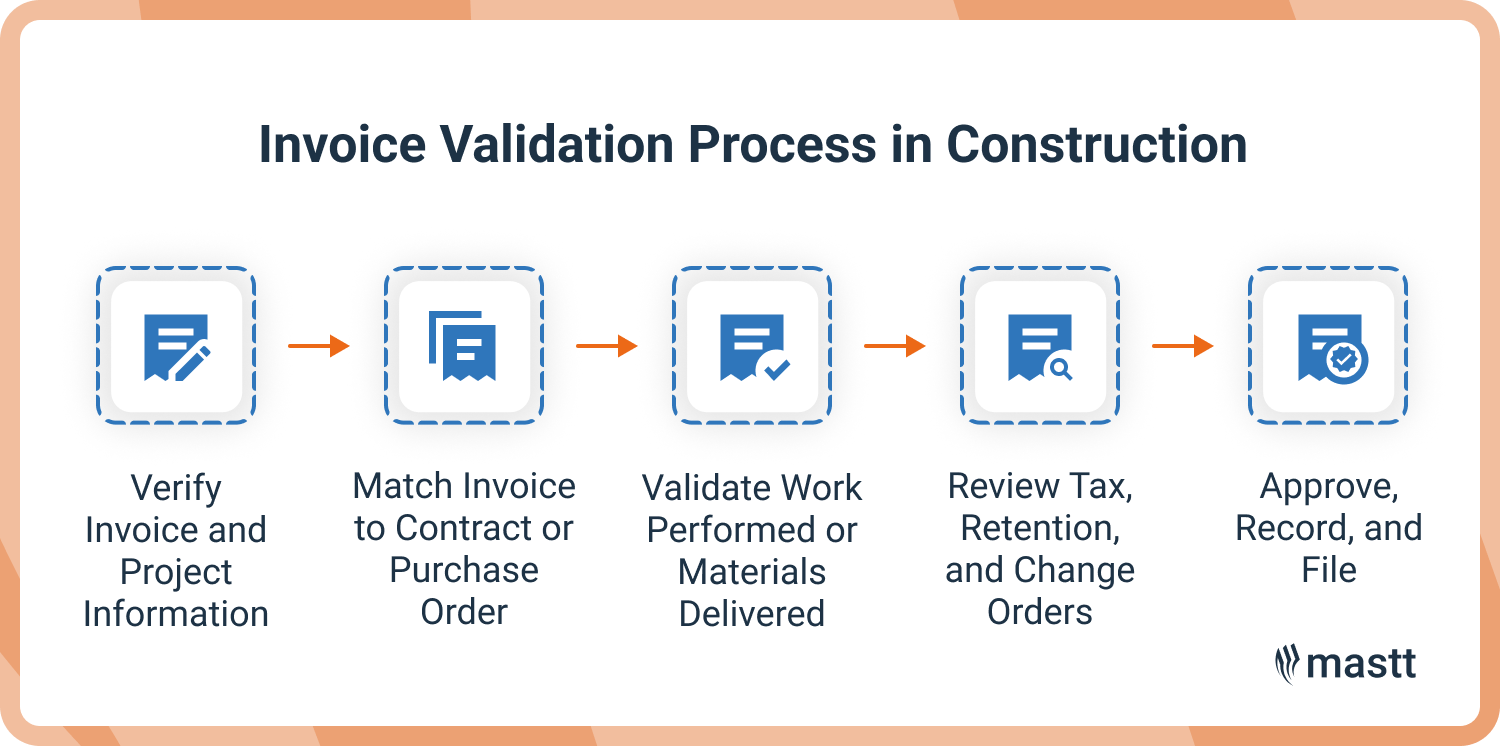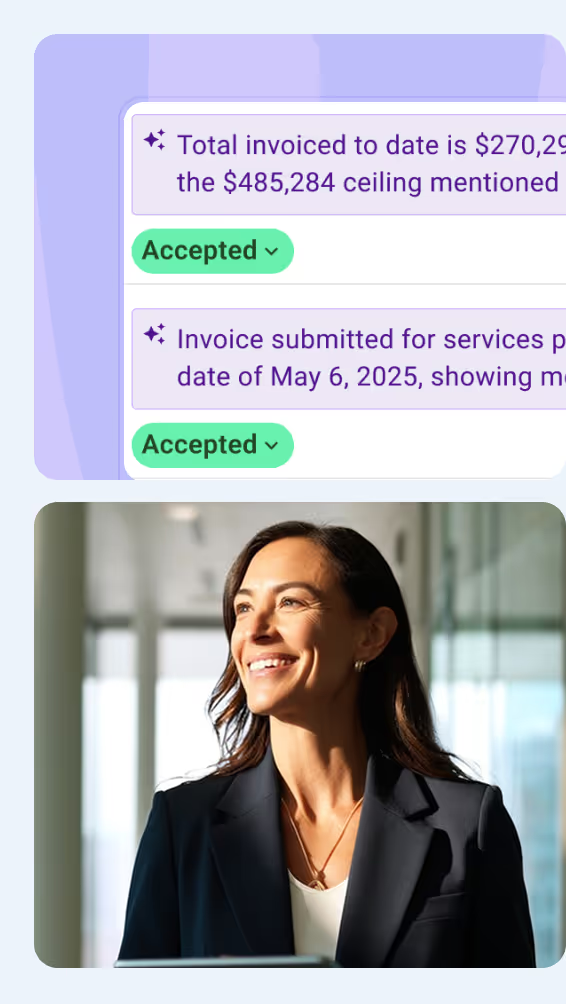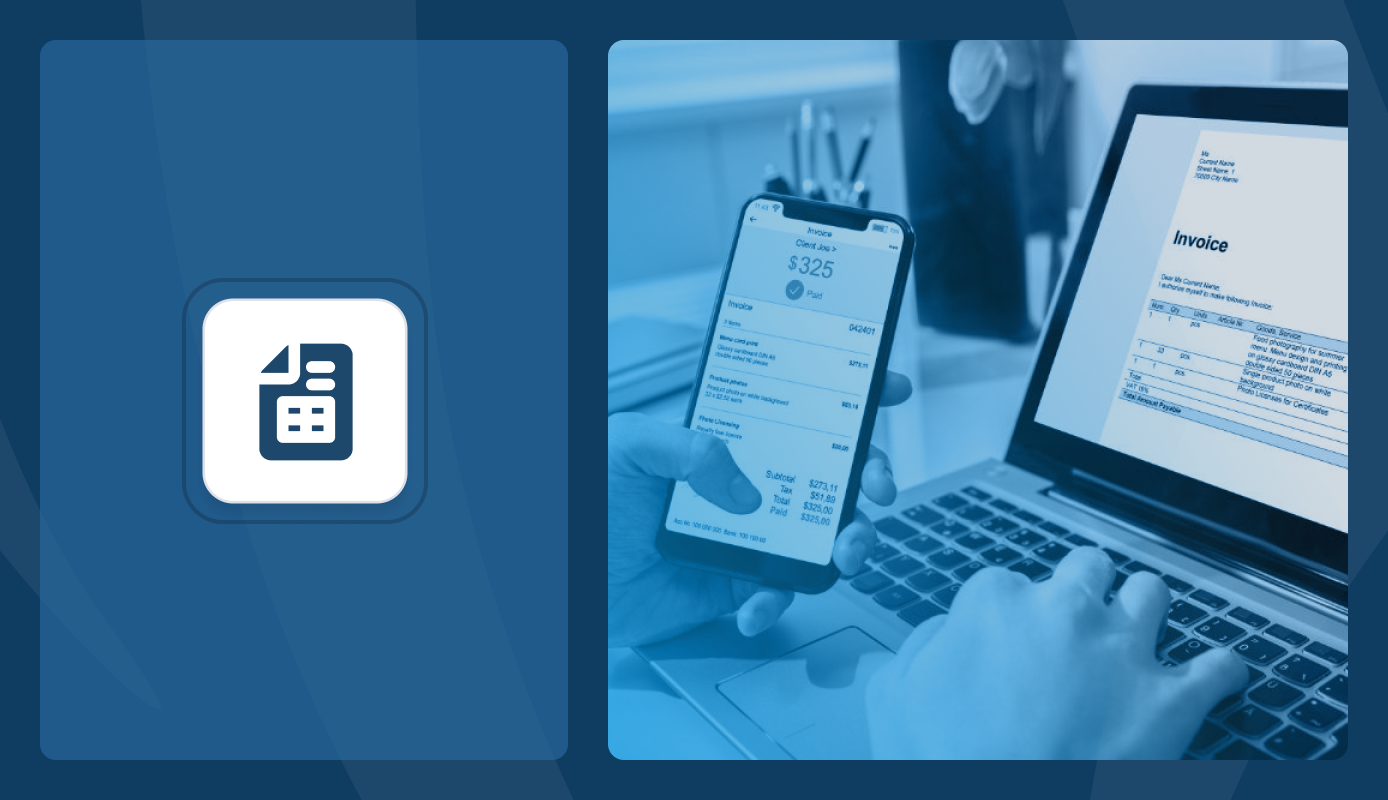Invoice validation is the process of verifying construction invoices for accuracy, compliance, and contract alignment before payment. It ensures the billed work and materials match what was agreed upon in the construction contract or purchase order.
In this article, you’ll learn how invoice validation fits into construction invoicing, the step-by-step process of validating invoices, and how software tools and AI can make the task faster and more reliable.
What is Invoice Validation in Construction?
Invoice validation is the review process that happens before an invoice is approved or paid. It’s a key step in construction invoicing that confirms the billed work, quantities, and materials match the contract, purchase order, and agreed scope.
In construction, this step happens between the subcontractor’s billing and the contractor’s payment approval. The team checks unit prices, quantities, and progress against delivery receipts, field reports, and site records to ensure the invoice reflects actual work completed.
For instance, if a subcontractor bills for 500 cubic yards of concrete, the validator compares that invoice amount with delivery tickets and daily logs. This goes beyond a simple invoice verification process, which only reviews surface details like totals or invoice date.
Why Invoice Validation Matters for Contractors and Subcontractors
Invoice validation keeps construction payments accurate, compliant, and dispute-free. It helps contractors and subcontractors confirm that every billed item reflects real work completed under the contract and that payment requests follow the right process.
- Prevents overbilling and fraudulent invoices: Ensures every line item billed matches approved work, materials, and contract rates.
- Reduces payment delays and disputes: Catches inconsistencies early so invoices don’t bounce between teams or hold up approvals, ensuring timely payment.
- Supports accurate job costing and cash flow tracking: Keeps project budgets aligned with actual progress and prevents surprise shortfalls.
- Strengthens relationships with all parties: Builds transparency and trust through consistent, verifiable billing.
- Builds compliance and audit confidence: Creates a clear audit trail that proves each payment follows the contract and legal requirements.
Without proper validation, small billing errors can quickly affect job costs and project timelines. A single overbilled line item or missing backup document can cause payment hold-ups, throw off project budgets, or trigger owner disputes.
Where Invoice Validation Fits in the Construction Invoicing Workflow
Invoice validation takes place between the subcontractor’s billing and the contractor’s payment approval. It’s the checkpoint that ensures invoices are accurate before they move through the construction invoicing workflow.
- Subcontractor submits invoice: The subcontractor sends an invoice with supporting documents such as delivery receipts, change orders, or progress reports.
- Contractor validates invoice details: The contractor reviews quantities, pricing, and supporting data to confirm alignment with the contract and approved work.
- Validated invoice becomes a pay application: Once confirmed, the validated invoice is included in the contractor’s pay application to the project owner.
- Project owner reviews and certifies payment: The owner or project manager reviews the pay application and issues certification for payment release.
💡 Pro Tip: Standardize your validation checkpoints. Define clear steps and approval thresholds for each stage of billing, from subcontractor submission and contractor validation to owner certification. This creates accountability, shortens turnaround times, and builds consistency across every project.
Who is Responsible for Invoice Validation
On the contractor’s side, invoice validation is a shared task handled by both field and office teams. Each role plays a part in checking accuracy, confirming delivery, and ensuring the invoice meets contract terms before payment approval.
- Project Manager: Reviews billed quantities, progress, and change orders to confirm that work aligns with what’s been completed on site.
- Contract Administrator: Checks that the invoice matches the contract, purchase order, and approved scope, and that retention and variations are correctly applied.
- Accounts Payable (AP) Team: Verifies invoice data, confirms tax and payment term, and enters approved invoices into the accounting or ERP system.
- Site Engineer or Supervisor: Confirms materials received and work performed through delivery receipts, field reports, and inspection sign-offs.
- Project Accountant: Ensures cost codes, budgets, and job costing reports align with validated invoice data before releasing for payment.
Each team member’s review creates a safeguard against billing errors and duplicate submissions. Clear role definitions also make validation faster and prevent back-and-forth between departments.

Invoice Validation Process in Construction
The invoice validation process starts with checking the accuracy of every incoming invoice before it enters the approval stage. It begins by confirming project and billing details, then moves through the validation of work performed and final approval.
Here are the key steps to validate a construction invoice effectively:
Step 1: Verify Invoice and Project Information
Confirm the invoice number, project name, billing period, and subcontractor details. Make sure reference numbers, tax IDs, and billing dates match the contract and pay cycle. Early checks prevent approval delays caused by small administrative errors.
💡 Tip: Set clear billing rules during subcontractor onboarding. Define acceptable invoice formats, required backup documents, and submission dates.
Step 2: Match Invoice to Contract or Purchase Order
Compare billed items against the contract or purchase order. Review unit prices, scope, and cost codes to confirm they align with agreed terms. For progress-based contracts, tie billed amounts to completed work or milestones.
💡 Tip: Standardize cost codes and retention rates across projects to make comparisons and reviews faster.
Step 3: Validate Work Performed or Materials Delivered
Cross-check the invoice with field logs, delivery receipts, and inspection reports. Confirm that the billed work or materials were received, approved, and recorded on-site. This step prevents overbilling or payment for incomplete work.
💡 Tip: Coordinate early with field teams. Cross-check quantities and progress logs before the payment deadline to resolve discrepancies early.
Step 4: Review Tax, Retention, and Change Orders
Check that tax, retention, and approved change orders are calculated correctly and backed by documentation. Each adjustment should be traceable to its contract clause or approval record.
💡 Tip: Reject incomplete or unverified invoices promptly and return them with clear feedback so subcontractors can revise and resubmit on time.
Step 5: Approve, Record, and File
Once verified, route the invoice through the internal approval workflow and record it in your accounting or ERP software. Store validated invoices and supporting files in a shared digital folder for audits and payment tracking.
💡 Tip: Automate repetitive checks using Optical Character Recognition (OCR) or AP software to flag duplicates, verify totals, and route invoices automatically to approvers.
Each step connects field operations with accounting, ensuring invoices reflect real progress and verified costs. Contractors who follow this invoice processing consistently maintain stronger cost control and avoid disputes over payment accuracy.

Common Invoice Validation Challenges and How to Avoid Them
Invoice validation issues often come from manual work, missing data, or unclear documentation. Contractors and project accountants face recurring billing errors that slow down payment cycles and create accounting mistakes.
Here’s a quick overview of the most common challenges and practical ways to avoid them:
Construction accounting mistakes often start small but compound quickly when teams skip validation steps. Automating document capture, linking invoices to project records, and using OCR for data accuracy can eliminate most of these issues.
Best Practices for Invoice Validation Before Owner Approval
The best way to validate invoices before submission is to start by reviewing progress and documentation early. Confirming accuracy before the billing deadline prevents payment delays, owner disputes, and rejected invoices. Contractors who double-check details before sending maintain smoother cash flow and stronger client trust.
- Reconcile billed work with actual progress: Confirm quantities and completion percentages against field reports and approved schedule of values.
- Include only verified subcontractor and supplier invoices: Make sure all invoices have been internally reviewed and matched to the proper scope of work.
- Attach the right supporting documents: Add approved change orders, delivery receipts, test results, and inspection reports to back up every cost.
- Validate invoices with AI tools: Contractors can validate their invoices before sending them using AI solutions like Mastt’s AI Payment Review to detect errors, confirm compliance, and save review time.
- Check all totals and retention calculations: Review math carefully to confirm accuracy and compliance with contract terms.
- Follow the owner’s required format: Use the correct billing form, such as AIA or a project-specific template, to avoid rework.
- Conduct a final internal review: Have a project manager or accountant review the entire billing package before submission.
Taking time to validate invoices at this stage improves cash flow and strengthens owner confidence. Owners are more likely to approve payments quickly when invoices are clear, consistent, and fully supported.
How to Simplify the Invoice Validation Process with Software and AI Automation
Contractors can speed up invoice validation by automating key steps, standardizing data, and connecting systems used across field and finance teams. The aim is to reduce manual validation time while maintaining accuracy, compliance, and payment control.
Here’s how contractors can make the invoice validation process quicker and more precise:
- Automate validation rules: Set up your AP or ERP system to flag incomplete, duplicate, or noncompliant invoices before approval.
- Use AI for exception handling: AI tools analyze past discrepancies and detect errors early, helping teams validate invoices with fewer manual checks.
- Adopt e-invoicing integration: Connect systems through standards like PEPPOL or XML for real-time data sharing between contractors and suppliers.
- Enable Straight-Through Processing (STP): Allow low-risk, verified invoices to move through automatically without manual intervention.
- Integrate bank data and financial records: Match invoices against payments automatically using banking APIs to prevent reconciliation delays.
- Leverage OCR for data extraction: OCR software captures and imports invoice data from PDFs or scans, reducing data entry errors.
Invoice validation becomes faster and more accurate when automation, consistent data, and connected systems work together. AI help contractors cut delays and reduce billing errors.
Here are the key features that make invoice validation software more effective for construction teams:
💡 Pro Tip: Use Mastt’s AI Payment Review to pre-validate invoices before approval. The tool automatically detects billing errors, duplicate entries, and missing documentation. It allows project accountants to focus only on flagged exceptions, speeding up approvals while maintaining full financial accuracy.
Automate Your Invoice Validation for Faster Payments
Strong invoice validation keeps construction payments accurate, compliant, and dispute-free. When contractors verify every charge against contracts and project records, they protect profit margins and maintain owner confidence.
If your team still relies on manual reviews, it’s time to upgrade. Tools like Mastt’s AI Payment Review help contractors validate invoices automatically, reducing errors, saving hours, and keeping cash flow moving on schedule.














.avif)



.avif)